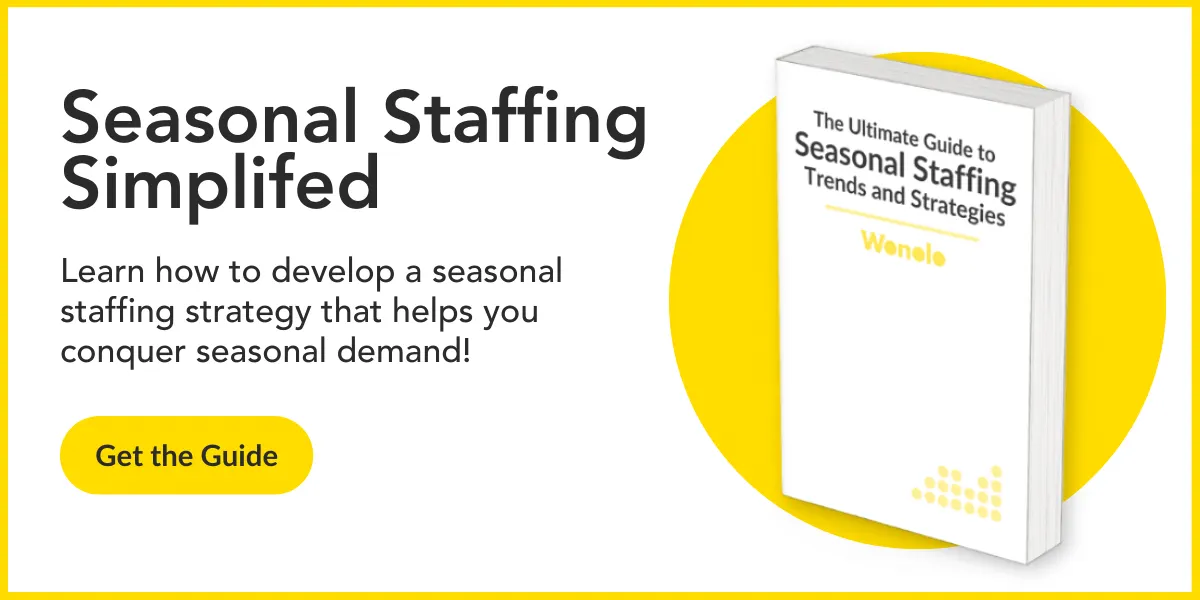Wonolo
At the end of each peak season, it’s important for businesses to evaluate their worker strategies to determine what went well and what needs improvement.
While conducting a post-season analysis, it is crucial to gather feedback from various stakeholders, including seasonal workers, regular employees, and other onsite personnel. This valuable feedback can provide insights into the effectiveness of your strategy and help set you up for even greater success leading into your next peak season. Consider the following approaches to collect feedback:
Gathering Input from Seasonal Workers: Conduct anonymous surveys or chat with workers at the end of their engagement to understand their experiences. Ask about their onboarding process (if applicable), the work environment, job satisfaction, and any suggestions they may have for enhancing your future seasonal efforts of finding workers.
Reviewing Performance Metrics and KPIs: Analyze performance metrics and key performance indicators for your jobs, including productivity, efficiency, and final work product. Compare these metrics against prior years to assess the overall impact of seasonal staffing on your company’s operations.
Making Adjustments for Future Seasons
Armed with the feedback and data from the previous season, take a proactive approach to refine your seasonal staffing strategies for the future. Implement continuous improvement plans to address any identified weaknesses in your strategy and capitalize on successful practices:
- Enhance Sourcing Efforts: Use the feedback received to fine-tune your worker sourcing processes. Consider refining job descriptions, modifying screening techniques, and identifying new channels to attract top talent for future seasonal jobs.
- Improve the Onsite Job Experience: Use the insights from seasonal workers’ feedback to address any challenges faced by seasonal workers and ensure they are able to hit the ground running and contribute effectively.
- Reassess Worker Allocation: Analyze the workload distribution during peak seasons and identify areas where temporary workers provided the most value. Adjust worker allocation to optimize the utilization of seasonal workers, potentially expanding or reducing the number of jobs as needed.
- Strengthen Worker Relations: Take steps to address any issues that may impact seasonal workers returning for future jobs. You can also offer incentives for returning seasonal workers, and provide opportunities for permanent roles when applicable.
- Stay Agile and Responsive: Remain adaptable to changing market trends and demands. Continuously monitor industry shifts and reassess your seasonal staffing plan accordingly to stay ahead of the competition.
Updating Labor Strategies Based on Trends
Stay abreast of seasonal staffing trends and industry best practices to ensure your strategies remain relevant and competitive. Attend industry conferences, participate in networking events, and keep an eye on emerging technologies that can streamline your processes.
By continually evaluating and refining your seasonal staffing strategies, your company can maximize the benefits of temporary workers during peak periods. An iterative approach to improvement ensures that each seasonal cycle is more efficient and productive than the last, contributing to your company’s long-term success and resilience in the face of seasonal demand fluctuations.
Need help preparing for seasonal demand? We created a comprehensive guide to help you design and implement a successful seasonal staffing strategy that empowers your business to thrive during peak demand periods. Click below to check out the full guide!







